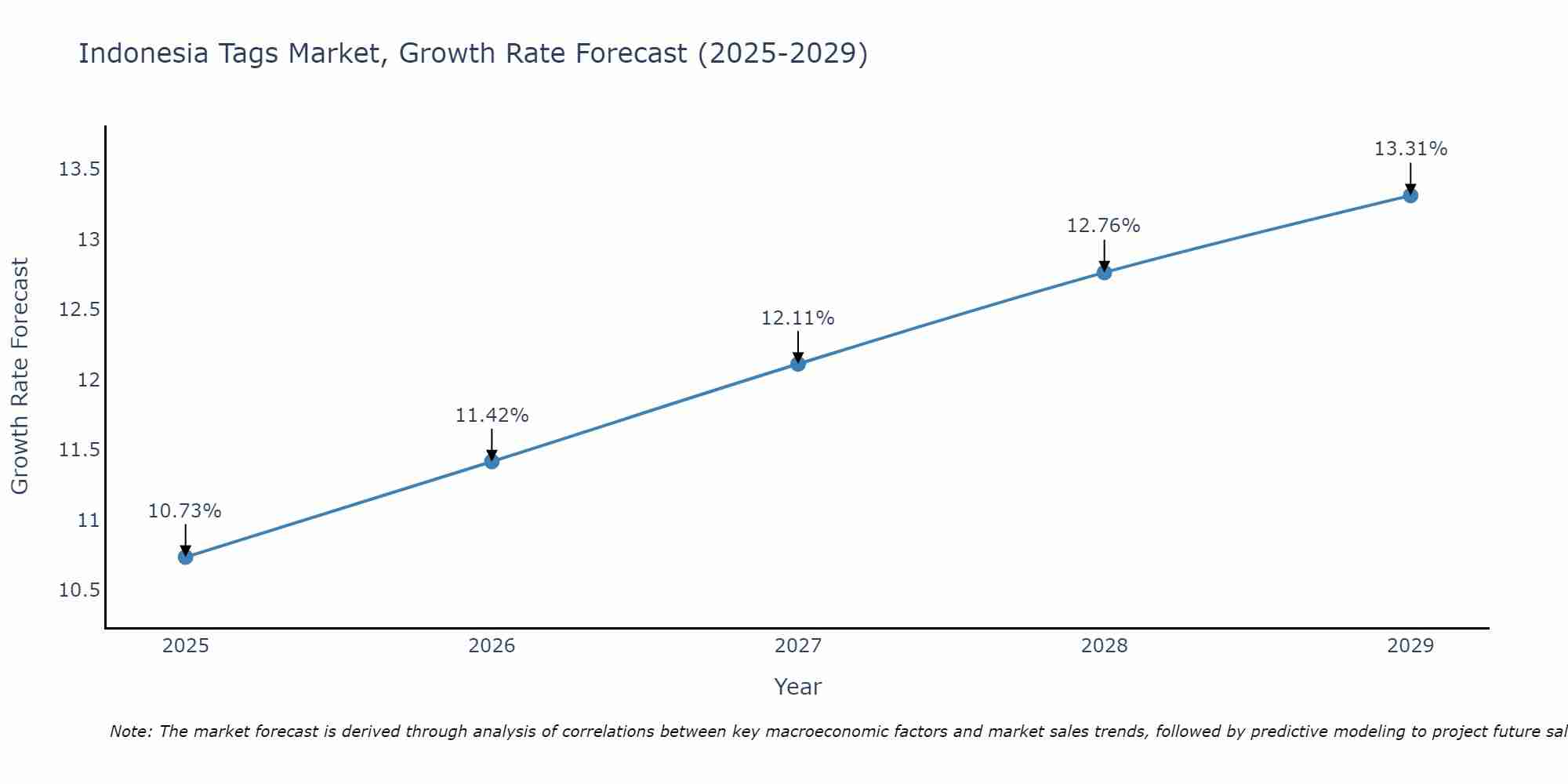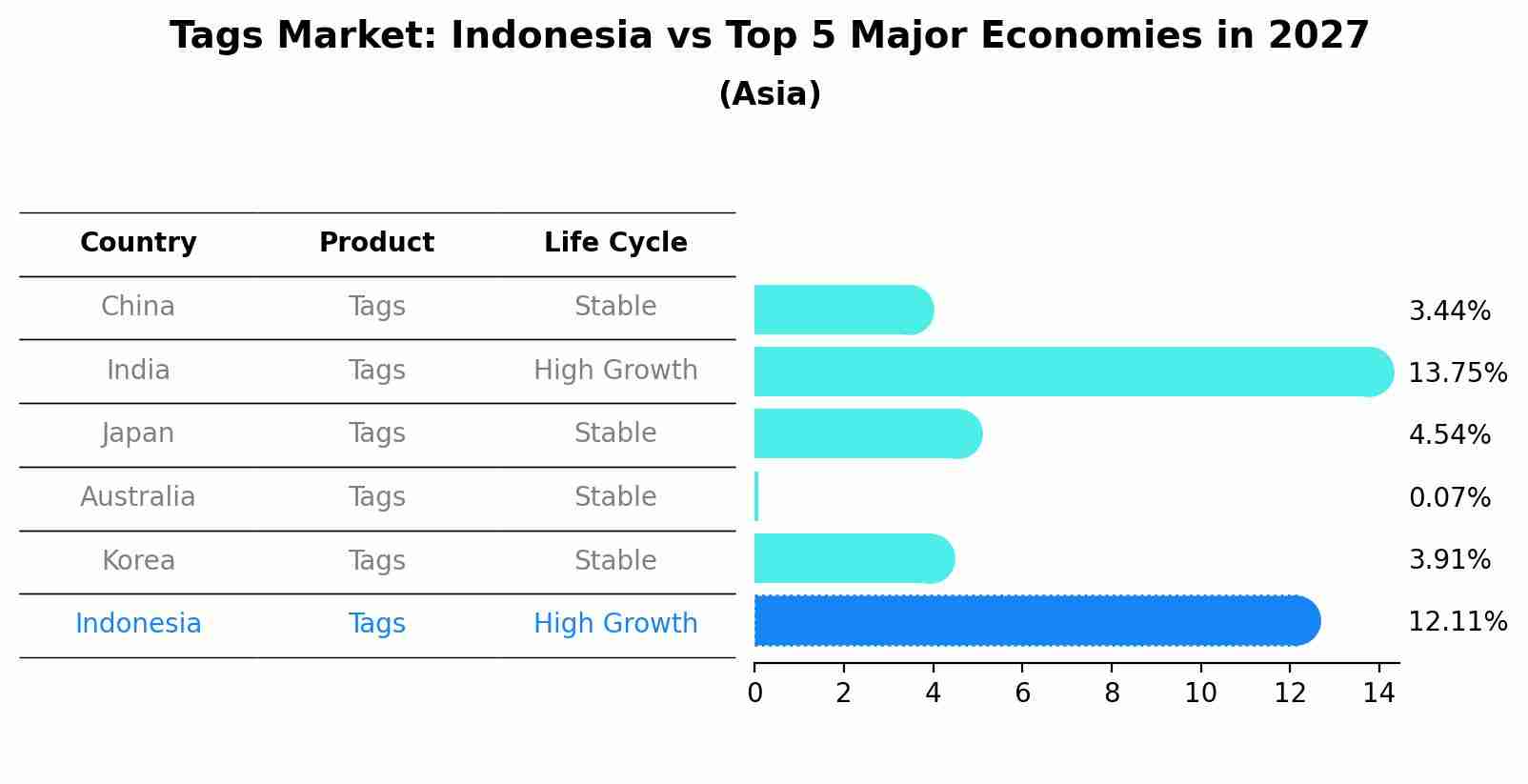Indonesia Tags Market (2025-2031) Outlook | Industry, Growth, Companies, Size, Value, Revenue, Share, Trends, Forecast & Analysis
| Product Code: ETC428064 | Publication Date: Oct 2022 | Updated Date: Apr 2025 | Product Type: Market Research Report | |
| Publisher: 6Wresearch | No. of Pages: 75 | No. of Figures: 35 | No. of Tables: 20 | |
Indonesia Tags Market Size Growth Rate
The Indonesia Tags Market is poised for steady growth rate improvements from 2025 to 2029. From 10.73% in 2025, the growth rate steadily ascends to 13.31% in 2029.

Tags Market: Indonesia vs Top 5 Major Economies in 2027 (Asia)
By 2027, the Tags market in Indonesia is anticipated to reach a growth rate of 12.11%, as part of an increasingly competitive Asia region, where China remains at the forefront, supported by India, Japan, Australia and South Korea, driving innovations and market adoption across sectors.

Indonesia Tags Market Synopsis
The tags market in Indonesia is driven by a diverse range of applications, including retail, logistics, and manufacturing. Tags play a crucial role in labeling and tracking products, ensuring efficient inventory management and supply chain operations. As e-commerce and retail industries continue to expand, the demand for tags, including RFID tags, has increased. Manufacturers are innovating to provide durable and efficient tagging solutions that can withstand various environmental conditions. Additionally, the adoption of smart tagging technologies is on the rise, further enhancing the market`s growth prospects.
Drivers of the Market
The Indonesia Tags market is poised for growth, primarily due to the booming retail and e-commerce sectors. With the increasing trend of online shopping, the demand for tags and labels for product identification and tracking has surged. Moreover, stricter regulations related to product labeling and traceability have further driven the need for high-quality tags. Additionally, the food and beverage industry in Indonesia is witnessing robust growth, creating opportunities for tags used for expiry date labeling and branding. The market is also benefiting from advancements in RFID technology, which enable real-time tracking and inventory management, thus enhancing efficiency for businesses.
Challenges of the Market
The tags market in Indonesia faces notable challenges. Counterfeit products and low-cost imitation tags can erode trust in the market. Moreover, ensuring the durability and reliability of tags in the country`s diverse climate conditions, from tropical humidity to heavy rain, can be challenging. Additionally, navigating intellectual property issues and protecting proprietary tag designs is crucial in a competitive market.
COVID-19 Impact on the Market
The tags market faced challenges as retailers and businesses temporarily closed or reduced their operations. This resulted in lower demand for product tags and labels. E-commerce businesses, on the other hand, saw an increase in demand for shipping and labeling solutions, partially offsetting the decline.
Key Players in the Market
In the Indonesia tags market, companies like PT Rimba Kencana Abadi produce tags and labels used in retail, branding, and product identification, offering a wide range of tagging solutions.
Key Highlights of the Report:
- Indonesia Tags Market Outlook
- Market Size of Indonesia Tags Market, 2024
- Forecast of Indonesia Tags Market, 2031
- Historical Data and Forecast of Indonesia Tags Revenues & Volume for the Period 2021-2031
- Indonesia Tags Market Trend Evolution
- Indonesia Tags Market Drivers and Challenges
- Indonesia Tags Price Trends
- Indonesia Tags Porter's Five Forces
- Indonesia Tags Industry Life Cycle
- Historical Data and Forecast of Indonesia Tags Market Revenues & Volume By Material Type for the Period 2021-2031
- Historical Data and Forecast of Indonesia Tags Market Revenues & Volume By Plastic for the Period 2021-2031
- Historical Data and Forecast of Indonesia Tags Market Revenues & Volume By Paper for the Period 2021-2031
- Historical Data and Forecast of Indonesia Tags Market Revenues & Volume By Fibers for the Period 2021-2031
- Historical Data and Forecast of Indonesia Tags Market Revenues & Volume By Others (Metal, etc.) for the Period 2021-2031
- Historical Data and Forecast of Indonesia Tags Market Revenues & Volume By Tag Type for the Period 2021-2031
- Historical Data and Forecast of Indonesia Tags Market Revenues & Volume By RFID Tag for the Period 2021-2031
- Historical Data and Forecast of Indonesia Tags Market Revenues & Volume By Hang/ Swing Tag for the Period 2021-2031
- Historical Data and Forecast of Indonesia Tags Market Revenues & Volume By Loop Tag for the Period 2021-2031
- Historical Data and Forecast of Indonesia Tags Market Revenues & Volume By End Use for the Period 2021-2031
- Historical Data and Forecast of Indonesia Tags Market Revenues & Volume By Food & Beverage for the Period 2021-2031
- Historical Data and Forecast of Indonesia Tags Market Revenues & Volume By Clothing & Apparels for the Period 2021-2031
- Historical Data and Forecast of Indonesia Tags Market Revenues & Volume By Hospitality & Travel for the Period 2021-2031
- Historical Data and Forecast of Indonesia Tags Market Revenues & Volume By Beauty & Personal Care for the Period 2021-2031
- Historical Data and Forecast of Indonesia Tags Market Revenues & Volume By Consumer Electronics for the Period 2021-2031
- Historical Data and Forecast of Indonesia Tags Market Revenues & Volume By Others for the Period 2021-2031
- Indonesia Tags Import Export Trade Statistics
- Market Opportunity Assessment By Material Type
- Market Opportunity Assessment By Tag Type
- Market Opportunity Assessment By End Use
- Indonesia Tags Top Companies Market Share
- Indonesia Tags Competitive Benchmarking By Technical and Operational Parameters
- Indonesia Tags Company Profiles
- Indonesia Tags Key Strategic Recommendations
Frequently Asked Questions About the Market Study (FAQs):
1 Executive Summary |
2 Introduction |
2.1 Key Highlights of the Report |
2.2 Report Description |
2.3 Market Scope & Segmentation |
2.4 Research Methodology |
2.5 Assumptions |
3 Indonesia Tags Market Overview |
3.1 Indonesia Country Macro Economic Indicators |
3.2 Indonesia Tags Market Revenues & Volume, 2021 & 2031F |
3.3 Indonesia Tags Market - Industry Life Cycle |
3.4 Indonesia Tags Market - Porter's Five Forces |
3.5 Indonesia Tags Market Revenues & Volume Share, By Material Type, 2021 & 2031F |
3.6 Indonesia Tags Market Revenues & Volume Share, By Tag Type, 2021 & 2031F |
3.7 Indonesia Tags Market Revenues & Volume Share, By End Use, 2021 & 2031F |
4 Indonesia Tags Market Dynamics |
4.1 Impact Analysis |
4.2 Market Drivers |
4.3 Market Restraints |
5 Indonesia Tags Market Trends |
6 Indonesia Tags Market, By Types |
6.1 Indonesia Tags Market, By Material Type |
6.1.1 Overview and Analysis |
6.1.2 Indonesia Tags Market Revenues & Volume, By Material Type, 2021-2031F |
6.1.3 Indonesia Tags Market Revenues & Volume, By Plastic, 2021-2031F |
6.1.4 Indonesia Tags Market Revenues & Volume, By Paper, 2021-2031F |
6.1.5 Indonesia Tags Market Revenues & Volume, By Fibers, 2021-2031F |
6.1.6 Indonesia Tags Market Revenues & Volume, By Others (Metal, etc.), 2021-2031F |
6.2 Indonesia Tags Market, By Tag Type |
6.2.1 Overview and Analysis |
6.2.2 Indonesia Tags Market Revenues & Volume, By RFID Tag, 2021-2031F |
6.2.3 Indonesia Tags Market Revenues & Volume, By Hang/ Swing Tag, 2021-2031F |
6.2.4 Indonesia Tags Market Revenues & Volume, By Loop Tag, 2021-2031F |
6.3 Indonesia Tags Market, By End Use |
6.3.1 Overview and Analysis |
6.3.2 Indonesia Tags Market Revenues & Volume, By Food & Beverage, 2021-2031F |
6.3.3 Indonesia Tags Market Revenues & Volume, By Clothing & Apparels, 2021-2031F |
6.3.4 Indonesia Tags Market Revenues & Volume, By Hospitality & Travel, 2021-2031F |
6.3.5 Indonesia Tags Market Revenues & Volume, By Beauty & Personal Care, 2021-2031F |
6.3.6 Indonesia Tags Market Revenues & Volume, By Consumer Electronics, 2021-2031F |
6.3.7 Indonesia Tags Market Revenues & Volume, By Others, 2021-2031F |
7 Indonesia Tags Market Import-Export Trade Statistics |
7.1 Indonesia Tags Market Export to Major Countries |
7.2 Indonesia Tags Market Imports from Major Countries |
8 Indonesia Tags Market Key Performance Indicators |
9 Indonesia Tags Market - Opportunity Assessment |
9.1 Indonesia Tags Market Opportunity Assessment, By Material Type, 2021 & 2031F |
9.2 Indonesia Tags Market Opportunity Assessment, By Tag Type, 2021 & 2031F |
9.3 Indonesia Tags Market Opportunity Assessment, By End Use, 2021 & 2031F |
10 Indonesia Tags Market - Competitive Landscape |
10.1 Indonesia Tags Market Revenue Share, By Companies, 2024 |
10.2 Indonesia Tags Market Competitive Benchmarking, By Operating and Technical Parameters |
11 Company Profiles |
12 Recommendations |
13 Disclaimer |
- Single User License$ 1,995
- Department License$ 2,400
- Site License$ 3,120
- Global License$ 3,795
Search
Related Reports
- Portugal Occupational Health & Safety Services Market (2025-2031) | Strategy, Consumer Insights, Analysis, Investment Trends, Opportunities, Growth, Size, Share, Industry, Revenue, Segments, Value, Segmentation, Supply, Forecast, Restraints, Outlook, Competition, Drivers, Trends, Demand, Pricing Analysis, Competitive, Strategic Insights, Companies, Challenges
- Netherlands Occupational Health and Safety Services Market (2025-2031) | Strategy, Consumer Insights, Analysis, Investment Trends, Opportunities, Growth, Size, Share, Industry, Revenue, Segments, Value, Segmentation, Supply, Forecast, Restraints, Outlook, Competition, Drivers, Trends, Demand, Pricing Analysis, Competitive, Strategic Insights, Companies, Challenges
- Belgium and Luxembourg Facility Management Market (2025-2031) | Strategy, Consumer Insights, Analysis, Investment Trends, Opportunities, Growth, Size, Share, Industry, Revenue, Segments, Value, Segmentation, Supply, Forecast, Restraints, Outlook, Competition, Drivers, Trends, Demand, Pricing Analysis, Competitive, Strategic Insights, Companies, Challenges
- Russia Women Intimate Apparel Market (2025-2031) | Strategy, Consumer Insights, Analysis, Investment Trends, Opportunities, Growth, Size, Share, Industry, Revenue, Segments, Value, Segmentation, Supply, Forecast, Restraints, Outlook, Competition, Drivers, Trends, Demand, Pricing Analysis, Competitive, Strategic Insights, Companies, Challenges
- Africa Chocolate Market (2025-2031) | Size, Share, Trends, Growth, Revenue, Analysis, Forecast, industry & Outlook
- Global Hydroxychloroquine And Chloroquine Market (2025-2031) | Industry, Trends, Size, Outlook, Growth, Value, Companies, Revenue, Analysis, Share, Forecast
- Saudi Arabia Plant Maintenance Market (2025-2031) | Industry, Size, Growth, Revenue, Value, Companies, Forecast, Analysis, Share & Trends
- Taiwan Electric Truck Market (2025-2031) | Outlook, Industry, Revenue, Size, Forecast, Growth, Analysis, Share, Companies, Value & Trends
- South Korea Electric Bus Market (2025-2031) | Outlook, Industry, Companies, Analysis, Size, Revenue, Value, Forecast, Trends, Growth & Share
- Africa Low Temperature Powder Coating Market (2025-2031) | Companies, Competition, Size, Challenges, Segmentation, Trends, Competitive, Industry, Supply, Strategy, Investment Trends, Growth, Segments, Restraints, Strategic Insights, Revenue, Share, Forecast, Drivers, Analysis, Pricing Analysis, Demand, Consumer Insights, Value, Opportunities, Outlook
Industry Events and Analyst Meet
Our Clients
Whitepaper
- Middle East & Africa Commercial Security Market Click here to view more.
- Middle East & Africa Fire Safety Systems & Equipment Market Click here to view more.
- GCC Drone Market Click here to view more.
- Middle East Lighting Fixture Market Click here to view more.
- GCC Physical & Perimeter Security Market Click here to view more.
6WResearch In News
- Doha a strategic location for EV manufacturing hub: IPA Qatar
- Demand for luxury TVs surging in the GCC, says Samsung
- Empowering Growth: The Thriving Journey of Bangladesh’s Cable Industry
- Demand for luxury TVs surging in the GCC, says Samsung
- Video call with a traditional healer? Once unthinkable, it’s now common in South Africa
- Intelligent Buildings To Smooth GCC’s Path To Net Zero













